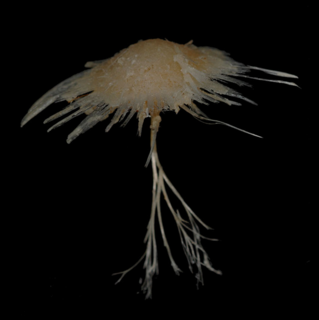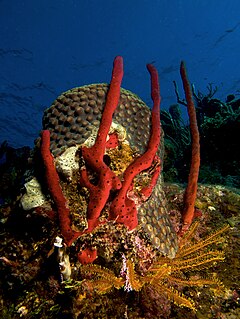
Cladorhiza is a genus of carnivorous sponges, comprising around 40 species found in oceans around the world. Cladorhiza is the type genus of the family Cladorhizidae.

The Clathrinida are an order of calcareous sponges found in marine environments. These sponges have an asconoid structure and lack a true dermal membrane or cortex. The spongocoel is lined with choanocytes.

Polymastia is a genus of sea sponges containing about 30 species. These are small to large encrusting or dome-shaped sponges with a smooth surface having many teat-shaped projections (papillae). In areas of strong wave action, this genus does not grow the teat structures, but instead grows in a corrugated form.
Acanthotetilla is a genus of demosponges belonging to the family Tetillidae. They are distinguished from others in the family by the presence of distinctive, heavily spined skeletal structures called "megacanthoxeas".

Homoscleromorpha is a class of marine sponges composed of two families: Plakinidae and Oscarellidae.

Plakinidae is a family of marine sponges composed of seven genera:
Clathrina multiformis is a species of calcareous sponge from Russia.
The genus name Aaata has been described as a synonym to two species in the Microcionidae family of sea sponges (Demospongiae). The two species being:
Racekiela ryderi is a species of freshwater sponge in the family Spongillidae. It was first described by Edward Potts in 1882. It was collected on Sable Island in 1899 by John Macoun, a biologist with the Geological Survey of Canada, and given the name Heteromeyenia macouni by A.H. Mackay in 1900. It was originally assumed to be endemic to Sable Island but is now considered to be the same species as Racekiela ryderi, which is more broadly distributed.

Amphimedon is a genus of sponges with over 60 described species. In 2009, Amphimedon queenslandica was the first species of sponge to have its genome sequenced.

Rhabdastrella is a genus of marine sponges belonging to the family of Ancorinidae.

Dictyoceratida is an order of sponges in the subclass Ceractinomorpha containing five families. Along with the Dendroceratida, it is one of the two orders of demosponges that make up the keratose or "horny" sponges, in which a mineral skeleton is minimal or absent and a skeleton of organic fibers containing spongin, a collagen-like material, is present instead.
Neopetrosia is a genus of marine petrosiid sponges. It was first established by the American spongiologist Max Walker de Laubenfels in 1932. It contains these 27 species:
Guancha apicalis was thought to be a species of calcareous sponge in the genus Guancha from Antarctica. It actually never existed.

Oscarellidae is a family of marine sponges.
Calthropella is a genus of sea sponges in the order Tetractinellida. It is the only genus in the monotypic family Calthropellidae.

Agelasida is an order of sea sponges in the class Demospongiae.
Merliida is an order of demosponges in the subclass Heteroscleromorpha.
Spongillida is an order of sea sponges in the subclass Heteroscleromorpha.










